Attached files
| file | filename |
|---|---|
| 8-K - 8-K - People's United Financial, Inc. | d730530d8k.htm |
 Investor Presentation
May 2014
Investor Contact:
Peter Goulding, CFA
203-338-6799
peter.goulding@peoples.com
Exhibit 99.1 |
 1
Forward-Looking Statement
Certain statements contained in this release are forward-looking in
nature. These include all statements about People's United
Financial's plans, objectives, expectations and other statements that
are not historical facts, and usually use words such as
"expect," "anticipate," "believe," "should" and
similar expressions. Such statements represent management's current
beliefs, based upon information available at the time the
statements are made, with regard to the matters addressed. All forward-
looking statements are subject to risks and uncertainties that could
cause People's United Financial's actual results or financial
condition to differ materially from those expressed in or implied by such
statements. Factors of particular importance to People’s United
Financial include, but are not limited to: (1) changes in
general, national or regional economic conditions; (2) changes in interest rates; (3)
changes in loan default and charge-off rates; (4) changes in
deposit levels; (5) changes in levels of income and expense in
non-interest income and expense related activities; (6) residential mortgage
and secondary market activity; (7) changes in accounting and regulatory
guidance applicable to banks; (8) price levels and conditions in
the public securities markets generally; (9) competition and its effect
on pricing, spending, third-party relationships and revenues; (10)
the successful integration of acquisitions; and (11) changes in
regulation resulting from or relating to financial reform legislation.
People's United Financial does not undertake any obligation to update
or revise any forward-looking statements, whether as a
result of new information, future events or otherwise. |
 2
Table of Contents
1.
Strategic Position
2.
Financial Performance
3.
Summary
4.
Appendix |
 3
Strategic Position |
 4
Corporate Overview
Snapshot as of March 31, 2014
People’s United Financial, Inc.
NASDAQ (PBCT)
Headquarters:
Bridgeport, CT
Chief Executive Officer:
Jack Barnes
Chief Financial Officer:
(1)
Kirk Walters
Market Capitalization (5/12/14):
$4.5 billion
Assets:
$33.1 billion
Loans:
$24.6 billion
Deposits:
$23.7 billion
Branches:
406
In-store Branches:
(2)
140
ATMs:
622
Standalone ATMs:
(3)
106
Founded:
1842
Notes:
1.
On April 16, 2014 People’s United announced the transition of CFO Kirk Walters for family
reasons. Walters will continue as CFO of People’s United Financial, Inc., the bank’s
holding company, and former Treasurer David Rosato has been appointed CFO of People’s
United Bank. Walters will continue to serve as CFO of People’s United Financial, Inc.
through December 31, 2014, when Rosato is expected to assume that position
2.
Exclusive relationship with Stop & Shop, a subsidiary of Ahold (ENXTAM:AH) 3.
Includes 20 ATMs in Stop & Shop locations where a branch is not present
|
 5
Compelling Investment Opportunity
Leading
market
position
in
the
best
commercial
banking
market
in
the
US
Significant
growth
runway
within
existing
markets
–
expanding
in
two
of
the
largest MSAs in the US (New York City, #1, Boston, #10)
Dividend yield in excess of 4.5%
Ability
to
maintain
pristine
credit
quality
–
no
credit
“events”
Improving profitability
Strong liquidity
Continued capital deployment via organic growth and dividends
|
 6
Retail & Business Banking Franchise
Distribution
400+ branches over 6 states
•
~33% of branches are in-store
600+ ATMs
Online & mobile banking
Call center operations located in Bridgeport,
CT and Burlington, VT
Scale
5 in deposit market share in New England *
Customer base
Approximately 850,000 commercial, business
banking, consumer and wealth management
relationships
* Source: SNL Financial
th |
 7
Strategic Focus of Deposit Franchise
Growth
Core customers and deposits
Multiple product households
Leverage employee expertise to drive sales
Brand execution
Employee expertise
Superior customer experience
In-store supermarket strategy
Leveraging the Citizen’s branch acquisition
Navigating a low rate environment
Balancing growth, retention and cost of funds
Constant evaluation of branch-level profitability
•
Consolidated 35 branches since the beginning of 2011, or ~9% of our
franchise |
 8
Strong Deposit Market Positions
Connecticut
Massachusetts
Vermont
New York
New Hampshire
Maine
#1 in Fairfield County, CT, 64 branches, $6.3BN deposits, 18.2% market share
Source: SNL Financial; FDIC data as of June 30, 2013; excludes trust institutions
Notes: PBCT branch count updated as of March 31, 2014
Branches
$BN
%
1
B of A
148
25.9
24.5
2
Webster
126
12.8
12.1
3
People's United
162
11.3
10.7
4
Wells Fargo
75
7.8
7.4
5
TD Bank
76
6.1
5.8
6
JPM Chase
54
4.8
4.5
7
First Niagara
85
4.3
4.1
8
Citi
21
3.0
2.9
9
Liberty
49
2.9
2.7
10
RBS
46
2.5
2.4
Branches
$BN
%
1
B of A
244
57.5
19.9
2
RBS
252
29.0
10.1
3
Santander
225
18.1
6.3
4
TD Bank
152
11.5
4.0
5
Eastern Bank
96
6.9
2.4
6
Independent Bank
83
4.9
1.7
7
Middlesex
30
3.5
1.2
8
People's United
54
3.1
1.1
9
Boston Private
11
3.0
1.0
10
First Republic
4
3.0
1.0
Branches
$BN
%
1
People's United
42
2.6
22.5
2
TD Bank
35
2.6
22.0
3
Merchants
32
1.3
10.8
4
RBS
21
0.8
7.0
5
KeyCorp
13
0.7
6.1
6
Northfield
13
0.5
4.4
7
Community
14
0.4
3.8
8
Union
12
0.4
3.5
9
Passumpsic
6
0.3
2.8
10
Berkshire Hills
7
0.3
2.7
Branches
$BN
%
1
RBS
74
6.7
23.9
2
TD Bank
73
5.8
20.5
3
B of A
27
4.6
16.3
4
People's United
28
1.3
4.6
5
NH Mutual
18
1.0
3.7
6
BNH
22
0.9
3.2
7
Santander
20
0.9
3.0
8
NH Thrift
21
0.8
2.8
9
Mascoma
19
0.7
2.6
10
Eastern
7
0.7
2.6
Branches
$BN
%
1
TD Bank
52
18.1
48.3
2
KeyCorp
54
2.5
6.6
3
Bangor Bancorp
60
2.2
5.8
4
Camden National
44
1.8
4.9
5
B of A
19
1.4
3.8
6
First Bancorp
16
1.0
2.7
7
Machias
17
0.9
2.3
8
People's United
26
0.9
2.3
9
Bar Harbor
16
0.9
2.3
10
Norway
22
0.8
2.1
Branches
$BN
%
1
JPM Chase
803
424.5
37.5
2
Citi
269
76.1
6.7
3
B of A
318
60.6
5.4
4
HSBC
157
59.0
5.2
5
Capital One
272
41.2
3.6
6
M&T
297
35.5
3.1
7
TD Bank
236
24.2
2.1
8
KeyCorp
254
19.6
1.7
9
First Niagara
203
17.2
1.5
10
Signature
28
15.3
1.4
28
People's United
94
2.7
0.2 |
 9
Large and Attractive Markets
NYC-Northern NJ-PA
Population: 19.7MM
Median HH Income: $62,660
Businesses: 810,883
Population Density (#/sq miles): 2,383
Unemployment Rate (%): 7.3
$100K+ Households (%): 32.4
Boston, MA
Population: 4.6MM
Median HH Income: $68,376
Businesses: 203,770
Population Density (#/sq miles): 1,321
Unemployment Rate (%): 5.7
$100K+ Households (%): 34.8
Hartford, CT
Population: 1.2MM
Median HH Income: $62,802
Businesses: 52,315
Population Density (#/sq miles): 804
Unemployment Rate (%): 7.3
$100K+ Households (%): 30.5
Bridgeport-Stamford, CT
Population: 926,000
Median HH Income: $78,297
Businesses: 49,392
Population Density (#/sq miles): 1,482
Unemployment Rate (%): 6.8
$100K+ Households (%): 40.1
New Haven, CT
Population: 863,000
Median HH Income: $57,071
Businesses: 36,800
Population Density (#/sq miles): 1,428
Unemployment Rate (%): 8.1
$100K+ Households (%): 28.2
Burlington, VT
Population: 215,000
Median HH Income: $59,264
Businesses: 10,846
Population Density (#/sq miles): 172
Unemployment Rate (%): 3.5
$100K+ Households (%): 25.2
Notes: The current national unemployment rate is 6.3%
The current national population density is 89 (#/sq miles)
Source: SNL Financial, US Census data
The population densities of NYC, Boston, Bridgeport and New Haven MSAs are each
over ten times the national average |
 10
Strong Market Demographic Profile
Source: SNL Financial, US Census data
Weighted Average Median Household Income
$68,013
$56,908
$51,314
$0
$10,000
$20,000
$30,000
$40,000
$50,000
$60,000
$70,000
$80,000
PBCT
Peer Median
US |
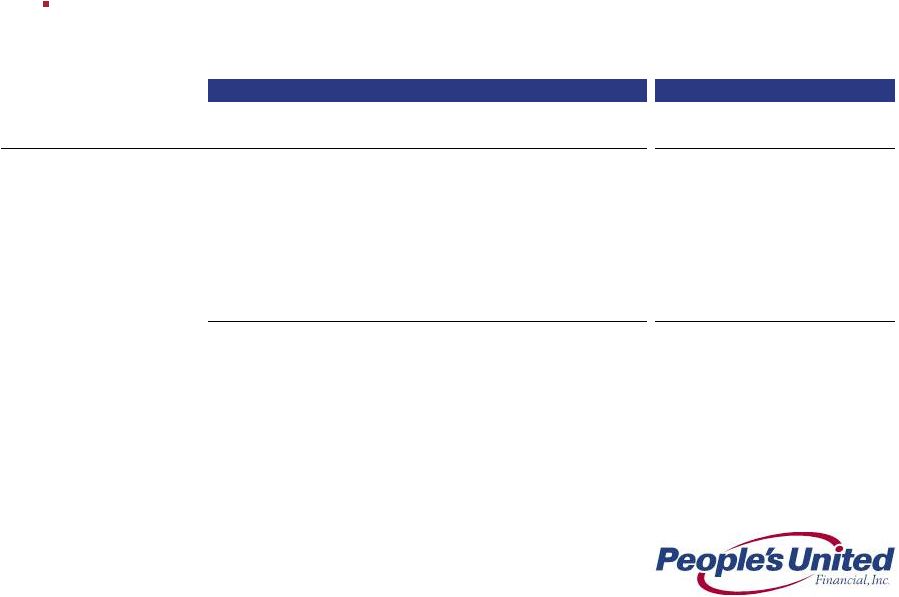 11
Attractive Market Demographics
Source: SNL Financial; FDIC data as of June 30, 2013
73% of People’s franchise deposits are in its top 5 MSAs, which are some of the most
densely populated and wealthy markets in the US
1.
Excludes deposits from trust institutions and branches with over $750MM deposits; excludes branches
and deposits located outside each
MSA 2.
Rank weighted by percentage of franchise deposits
People's
Franchise
Metrics
¹
MSA Rank out of 917 Nationwide MSAs
Market Size
Population
Median
% Households
Total Deposits
Market
% Deposit
Number of
Deposits
% of
Density
Household
with $200k+
People's United Top 5 MSAs
($MM)
Rank
Market Share
Branches
($MM)
Franchise
(# / sq. mile)
Income
Income
Bridgeport-Stamford-Norwalk, CT
$33,849
1
18.4%
65
$6,241
28.9
6
7
1
Boston-Cambridge-Newton, MA-NH
124,602
11
2.2
52
2,772
12.6
9
16
10
New York-Newark-Jersey City, NY-NJ-PA
594,328
31
0.5
97
2,716
12.4
2
33
8
Hartford-West Hartford-East Hartford, CT
26,227
4
8.1
45
2,119
9.6
20
32
28
New Haven-Milford, CT
17,868
4
11.4
34
2,032
9.2
7
70
41
Top 5 MSAs
$796,873
–
2.0%
293
$15,879
72.7
–
–
–
Weighted
Average
Rank
²
–
–
–
–
–
8
24
12
Rank / Nationwide MSAs (917 MSAs)
–
–
–
–
–
0.9%
2.7%
1.4% |
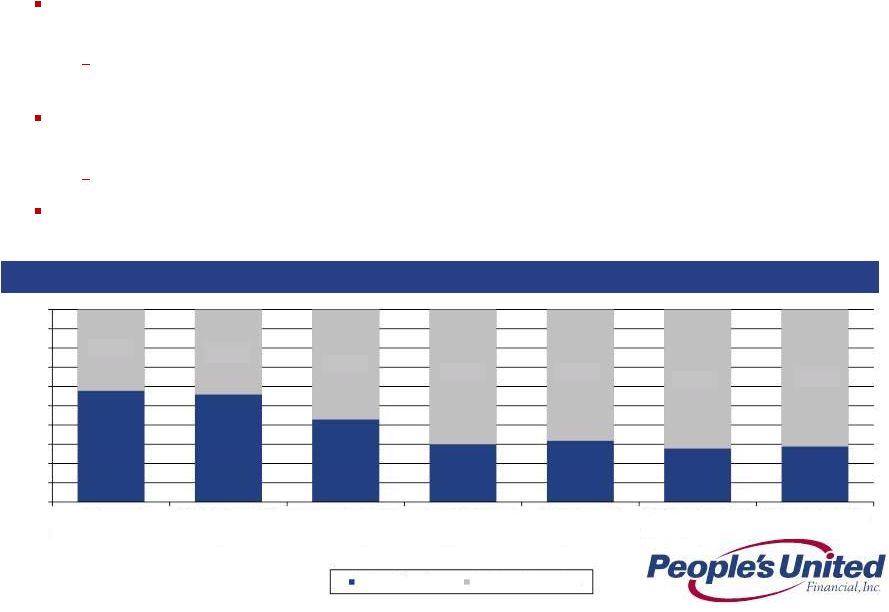 12
Connecticut
In-store
Versus
Traditional
Branch
Business
(Last
Twelve
Months
Through
3/31/14)
In-store Versus Traditional Branches
Connecticut
On average, in-store locations are open 37% more hours per week than traditional
branches (56 hours vs. 41 hours) but are 30% less expensive to operate
Partnership allows us to leverage our brand with the ~1.8 million shoppers who
visit Connecticut Stop & Shop stores every week
In-store locations operate under the same business model as traditional branches
and sell all the Bank’s products and services
Mortgages, Home Equity Loans, Business Loans and Investments*
Connecticut in-store branches accounted for a significant portion of the new
branch business booked in the market
58%
56%
43%
30%
32%
28%
29%
42%
44%
57%
70%
68%
72%
71%
0%
10%
20%
30%
40%
50%
60%
70%
80%
90%
100%
Consumer
Checking Accounts
Opened
Savings Accounts
Opened
Business Checking
Accounts Opened
Home Equity Loan
Originations
Mortgage Loan
Originations
Business Banking
Loan Originations
Investment Sales
In-store Branches
Traditional Branches
* Sold by employees who are also licensed representatives of our brokerage affiliate |
 Financial Performance |
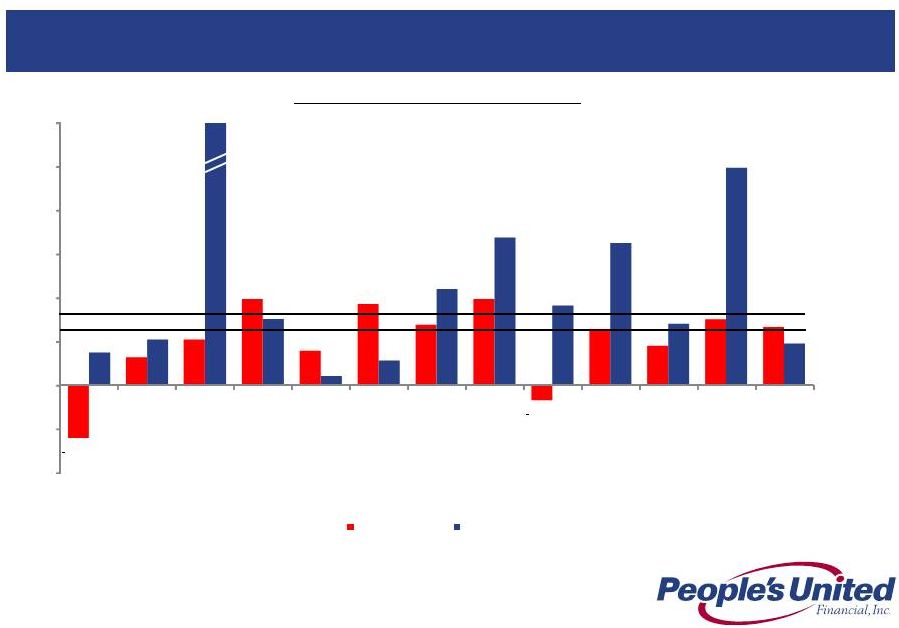 14
Consistent Loan Growth
Since the end of 2010, People’s United is one of only six banks within the top 50 by
assets that have grown loans in each quarter
¹
Source:
SNL Financial. Excludes trust banks. Statements based on Total Gross Loans and Finance Leases, as
reported, net of unearned discounts and gross of loss reserves. Does not include
accrued interest on loans
Notes:
1
Top 50 banks by assets as of most recent year end; includes People’s United, First Niagara, First
Republic, Signature, UMB and Investors
2
Reflects completion of Danvers Bancorp acquisition in 2Q 2011
3
Based on 48 of the top 50 banks reporting
Quarterly Loan Growth Since 1Q 2011
PBCT Median = 1.52%
Top 50 Median = 1.28
1.23%
0.64%
1.04%
1.97%
0.78%
1.86%
1.38%
1.97%
0.35%
1.28%
0.90%
1.51%
1.33%
0.75%
1.04%
1.52%
0.21%
0.57%
2.20%
3.38%
1.82%
3.25%
1.40%
4.98%
0.95%
-2%
-1%
0%
1%
2%
3%
4%
5%
6%
2011Q1
2011Q2
2011Q3
2011Q4
2012Q1
2012Q2
2012Q3
2012Q4
2013Q1
2013Q2
2013Q3
2013Q4
2014Q1
13.86%
2
3
Top 50 Median
PBCT |
 15
Revenue Opportunities
Continue to deepen our presence in heritage markets such as Connecticut and
Vermont
Substantial growth prospects in larger markets such as New York metro and
greater Boston
New York:
•
18 commercial relationship managers up from zero in 1Q 2010
•
94 branches up from 5 in 1Q 2010; 57 branches, or ~60%, are in-store locations
•
Total deposit growth of $2.7BN, or 77% compound annual growth, since 1Q 2010
Massachusetts:
•
33 commercial relationship managers up from 14 since 2010
•
54 branches up from 19 in 1Q 2010
•
Total deposit growth of $2.3BN, or 37% compound annual growth, since 1Q 2010
Notes:
1
Data as of March 31, 2014
1
1 |
 16
Under-represented asset classes ramping up
Bolstered commercial banking presence in greater Boston and Long Island
Building mid-corporate and government banking productivity
New
York
Commercial
Real
Estate
gaining
traction
as
evidenced
by
strong
growth
Increased Private Banking activity with initial focus on CT, metro New York and
greater Boston Steady asset-based lending and mortgage warehouse lending
progress Enhancing wealth management offering
Added seasoned wealth management team in Hartford area
Proprietary asset allocation and risk management strategies are implemented both
internally and with a suite of external managers who represent our "best
in class" recommendations •
Unified
Managed
Account
technology
allows
us
to
“rent”
intellectual
capital
–
no
customer
funds
leave
the
bank
Increasing momentum in other fee income businesses with a focus on
cross-sell Delivering interest rate swaps and foreign exchange products
to corporate customers Expanding international trade finance with the recent
hire of a senior executive Growing cash management, merchant and payroll
services Revenue Opportunities
Multiple Levers for Growth |
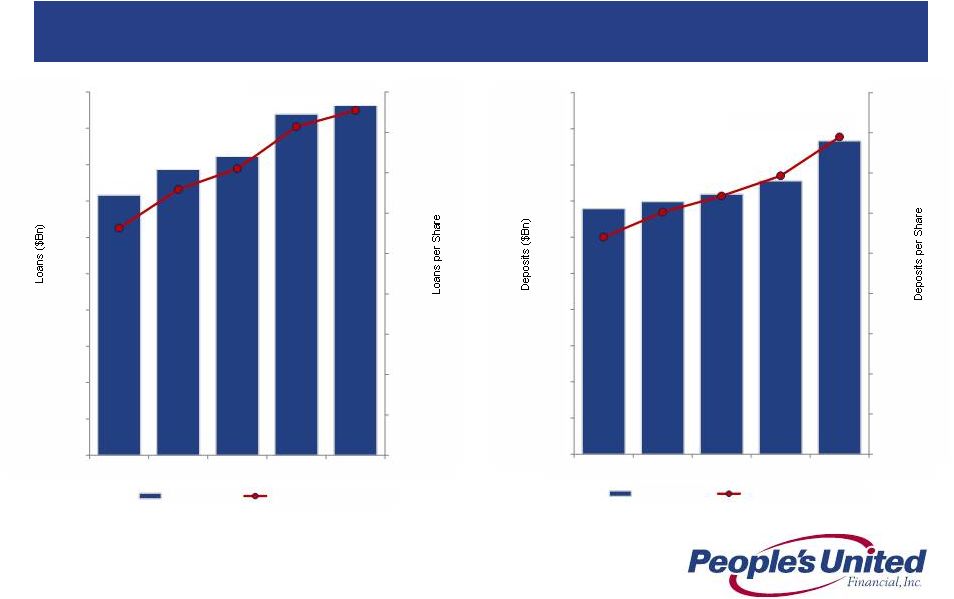 17
Growing Future Earnings Per Share
Loans and Deposits per Share
$82.73
$40
$45
$50
$55
$60
$65
$70
$75
$80
$85
$15
$16
$17
$18
$19
$20
$21
$22
$23
$24
$25
1Q13
2Q13
3Q13
4Q13
1Q14
Loans ($BN)
Loans per Share
$79.49
$40
$45
$50
$55
$60
$65
$70
$75
$80
$85
$15
$16
$17
$18
$19
$20
$21
$22
$23
$24
$25
1Q13
2Q13
3Q13
4Q13
1Q14
Deposits ($BN)
Deposits per Share
We have made substantial progress over the past year, growing loans and deposits at
compound annual growth rates of 21% and 19%, respectively
|
 18
EMOC has been fully operational since November 2011
Three person committee comprised of the CFO of the Bank, Chief Administrative
Officer and Chief HR Officer
EMOC oversees PBCT’s non-interest expense management, implements strategies
to ensure attainment of expense management targets and oversees revenue
initiatives that require expenditures
Provides a horizontal view of the organization
Expense Management Units (EMUs) established to facilitate EMOC functions
Defined EMUs include:
•
Technology
•
Operations
•
Real Estate Services
Spending requests above $25,000 are submitted by EMU owners for approval
Staffing models, staffing replacements and additions for mid-level positions and
above require approval by the Committee
Introduction to EMOC
Expense Management Oversight Committee (EMOC)
•
Employment/Benefits
•
Marketing
•
Regulatory/Institutional
•
Depreciation/Equipment
•
Decentralized
•
Intangible Amortization |
 19
Expense Progress
Estimated Cost Savings Analysis
Source:
SNL Financial
Notes:
“Pro Forma / Actual”
represents PBCT operating non-interest expense and the actual expenses at the acquired
institutions Acquisition target costs fall away as the acquisitions are completed
“Without Expense Initiatives”
represents PBCT operating non-interest expense and the actual expenses at the acquired
institutions in 4Q09, and then applies the peer median expense growth rate in each subsequent
quarter Our 1Q 2014 operating expense base of $212MM reflects $22MM (~$90MM annualized)
savings from successfully-executed expense initiatives
212
234
200
210
220
230
240
250
4Q09
1Q10
2Q10
3Q10
4Q10
1Q11
2Q11
3Q11
4Q11
1Q12
2Q12
3Q12
4Q12
1Q13
2Q13
3Q13
4Q13
1Q14
Operating Noninterest Expense ($MM)
Pro Forma / Actual
Without Expense Initiatives
$22MM
Cost
Savings |
 20 234
212
7
15
$0
$50
$100
$150
$200
$250
Without Expense
Initiatives
Announced Acquisition
Savings
Other Initiatives
Pro Forma / Actual
Operating Noninterest Expense ($MM)
Expense Progress
Estimated Cost Savings Analysis
The $22MM in quarterly cost reductions is attributable to efforts related to
acquisition cost savings and other initiatives
Source: SNL Financial
Notes:
“Pro Forma / Actual” represents PBCT operating non-interest expense and the actual
expenses at the acquired institutions Acquisition target costs fall away as the
acquisitions are completed “Without Expense Initiatives” represents PBCT operating non-interest expense and
the actual expenses at the acquired institutions in 4Q09, and then applies the peer median
expense growth rate in each subsequent quarter |
 21
Average Annual Net Charge Offs / Average Loans (%)
Peer Group Comparison, 2009-2013
Conservative underwriting is a hallmark of this institution
Median, excluding PBCT = 0.95%
Source: SNL Financial
0.28
0.00
0.50
1.00
1.50
2.00
2.50
3.00
3.50
4.00
PBCT |
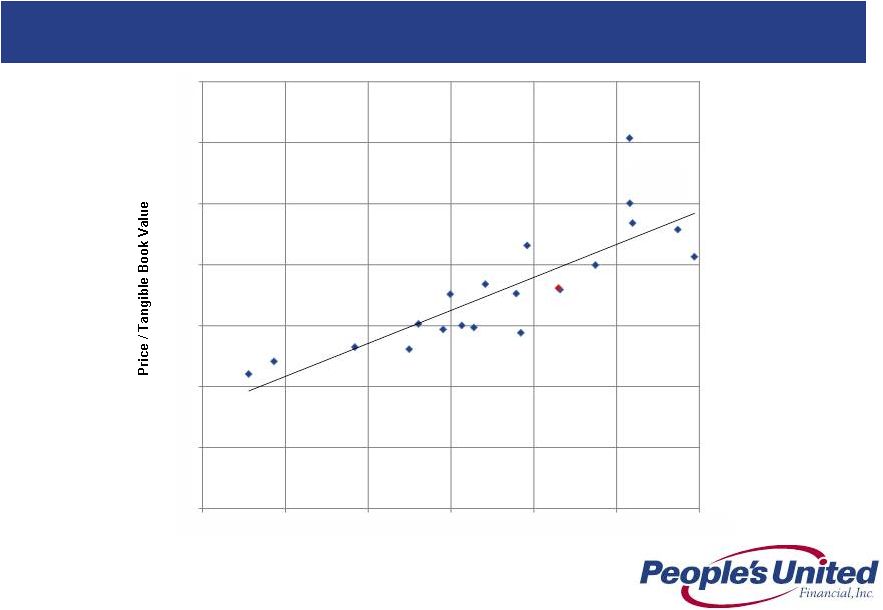 22
P/TBV vs. ROATE
Peer Group Regression Analysis
Source: SNL Financial
Note: Analysis utilizes SNL 3 Year Betas, as of May 12, 2014
R²
= 0.69
0
50
100
150
200
250
300
350
-5.0%
-3.0%
-1.0%
1.0%
3.0%
5.0%
7.0%
2015E Return on Average Tangible Equity Less Cost of Equity
PBCT
Improved profitability, predictability of earnings and a strong dividend will create
additional shareholder value |
 Summary |
 24
Summary
Sustainable Competitive Advantage
Premium brand built over 170 years
High quality Northeast footprint characterized by wealth, density and
commercial activity
Strong leadership team
Solid net interest margin
Superior asset quality
Focus on relationship-based banking
Growing
loans
and
deposits
within
footprint
-
in
two
of
the
largest
MSAs
in
the country (New York City, #1 and Boston, #10)
Improving profitability
Consistently returning capital to shareholders
Strong capital base |
 Appendix |
 26
Net Interest Income (Fully Taxable Equivalent)
Linked Quarter Change
(in $ millions)
229.5
231.8
(3.4)
(3.1)
(0.3)
2.4
6.7
4Q 2013
Calendar
Days
Acquired
Loans
Borrowings
Originated
Loans
Investments
1Q 2014 |
 27
Net Interest Margin (%)
Linked Quarter Change
3.24%
(0.05%)
(0.05%)
(0.01%)
0.03%
0.01%
3.17%
4Q 2013
Calendar
Days
New Loan
Volume
Loan
Mix
Investments
Deposits
1Q 2014 |
 28
Agency MBS and Agency CMOs comprised of 10 year and 15 year collateral
constitute ~80% of the portfolio. $600MM municipal bond portfolio has an
underlying weighted average credit rating above AA
Securities Portfolio Detail
1Q14 Total Securities Portfolio
$4.7 BN
($ in billions)
Note:
Agency CMO's, $2.3,
49%
Agency MBS, $1.4, 30%
Municipal
-
HTM, $0.6,
13%
FHLB Stock, $0.2, 4%
Bonds, Notes and
Debentures -
AFS, $0.1,
2%
Corporate
-
HTM, $0.1,
2%
Duration of the securities portfolio is ~4 years
Securities portfolio does not contain CLOs, CDOs, trust preferred, or private-label
mortgage-backed securities |
   29
Loans
Linked Quarter Change
(in $ millions)
Annualized Linked QTD change
3.9%
24,390
257
96
(114)
24,629
Dec 31, 2013
Commercial
Retail
Acquired
Mar 31, 2014 |
 30
1Q14 Total Loan Portfolio
$24.6 BN
Loans by Business Line
Note:
Commercial represents Commercial & Industrial and Equipment Finance
CRE
$9.0
37%
Commercial
$9.0
36%
Residential
Mortgage
$4.5
18%
Consumer
$2.1
9% |
 31
Loans by Geography
Excluding equipment
finance loans, ~95%
of our 1Q14 loan
portfolio is within the
Northeast
1Q14 Total Loan Portfolio
$24.6 BN
Connecticut
$7.0
28%
New York
$4.5
18%
Massachusetts
$4.3
18%
Vermont
$1.8
7%
New Hampshire
$1.3
6%
Maine
$0.9
4%
New Jersey
$0.8
3%
Other
$4.0
16% |
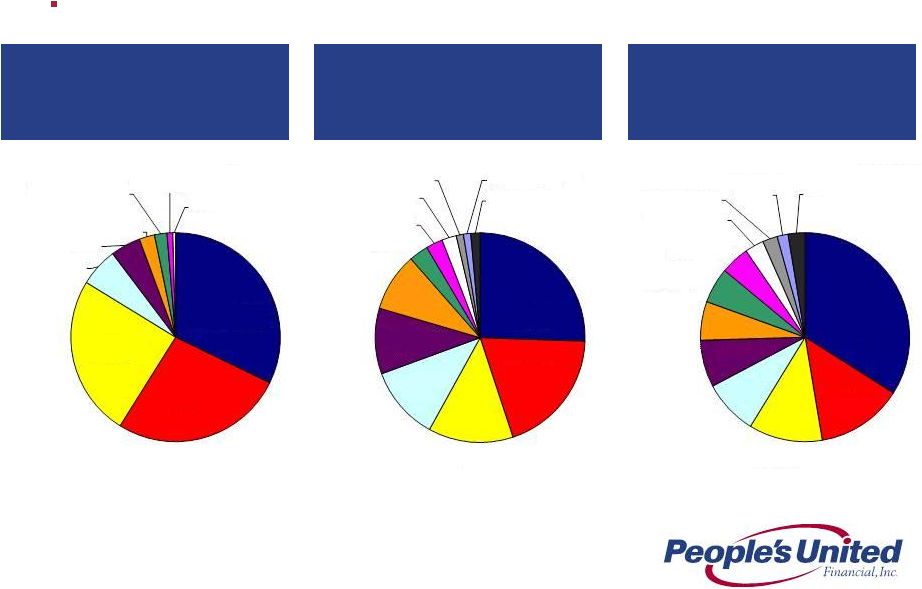 32
Commercial Real Estate,
$9.0BN, 37% of Total
Equipment Financing,
$2.6BN, 10% of Total
Commercial & Industrial,
$6.4BN, 26% of Total
($ in billions)
($ in billions)
($ in billions)
Commercial Loan Portfolio Detail
1Q 2014
73% of total loan portfolio
Residential (Multi-
family), $2.9, 32%
Retail, $2.4, 27%
Office Buildings,
$2.2, 25%
Industrial/Manufact.,
$0.5, 6%
Hosp. &
Entertainment, $0.4,
5%
Mixed/Special
Use, $0.2, 2%
Self Storage, $0.2, 2%
Land, $0.1, 1%
Healthcare, $0.1, 0%
Finance, Ins. & RE,
$1.6, 26%
Service, $1.2, 19%
Manufacturing, $0.8,
13%
Health, $0.7,
11%
Wholesale Dist.,
$0.7, 10%
Retail
Sales,
$0.6, 9%
Construction, $0.2, 3%
Transp/Utility, $0.2,
3%
Arts/Ent./Recr., $0.1,
2%
Public Admin,
$0.1, 1%
Agriculture, $0.1, 1%
Other, $0.1, 2%
Transp/Utility, $0.9,
34%
Construction,
$0.3, 13%
Finance, Ins. & RE,
$0.3, 11%
Printing,
$0.2, 9%
Waste, $0.2, 7%
Manufacturing,
$0.2, 6%
Packaging, $0.1, 6%
Wholesale
Dist., $0.1, 4%
Mining, Oil & Gas,
$0.1, 3%
Service, $0.1, 2%
Health Services,
$0.0, 2%
Other, $0.1, 3% |
 33
Residential Mortgage,
$4.5BN, 18% of Total
1Q 2014 originated weighted average LTV of 68%
1Q 2014 originated weighted average FICO score of 754
Hybrid ARMs represent ~90% of the portfolio
($ in billions)
Retail Loan Portfolio Detail
1Q 2014
Consumer,
$2.1BN, 9% of Total
1Q 2014 originated weighted average CLTV of 58%
1Q 2014 originated weighted average FICO score of 765
~60% of originations during last 3 years are in a first lien position
($ in billions)
27% of total loan portfolio
CT, $2.2, 49%
MA, $1.2, 27%
NY, $0.4, 9%
VT,
$0.3,
7%
NH, $0.2, 4%
ME, $0.1, 3%
Other, $0.1, 1%
CT, $1.3, 61%
VT, $0.2, 11%
MA, $0.2, 8%
NY, $0.2,
8%
NH,
$0.1,
6%
ME, $0.1, 6% |
 34
Net Interest Income (NII) Sensitivity
Interest Rate Risk Profile
Notes:
1.
Yield curve twist pivot point is 18 month point on yield curve.
Short
End defined as overnight to 18 months. Long End defined
as terms greater than 18 months
1
-1.0%
3.4%
7.5%
10.9%
14.3%
-1.2%
3.1%
7.3%
10.7%
14.1%
-5.0%
0.0%
5.0%
10.0%
15.0%
20.0%
Dn25
Up100
Up200
Up300
Up400
Immediate Parallel Shock
3/31/14
12/31/13
-0.1%
1.0%
2.9%
-3.7%
2.5%
4.8%
-0.4%
0.7%
2.7%
-3.7%
2.3%
4.7%
-6.0%
-4.0%
-2.0%
0.0%
2.0%
4.0%
6.0%
Short End -25
Short End +100
Short End +200
Long End -100
Long End +100
Long End +200
Yield Curve Twist
3/31/14
12/31/13
34 |
 35
Acquired Loan Portfolio
Acquired loans initially recorded at fair value (inclusive of related credit mark)
without carryover of historical ALLL
Accounting model is cash-flow based:
Contractual
cash
flows
(principal
&
interest)
less
expected
cash
flows
(principal
&
interest)
=
non-accretable
difference (effectively utilized to absorb actual portfolio losses)
Expected cash flows (principal & interest) less fair value = accretable
yield Expected cash flows are regularly reassessed and compared to actual cash
collections As of 3/31/14
(in $ millions)
Carrying
Amount
a, b
Carrying Amount Component
b
NPLs
Non-Accretable
Difference/NPLs
Charge-offs
Incurred Since
Acquisition
d
Accretable
Yield
Non-Accretable
Difference
Danvers (7/1/11)
$712.8
$245.1
$13.2
$46.1
29%
$23.9
Smithtown (11/30/10)
445.9
203.9
95.2
76.3
125%
128.4
Others (various dates)
252.0
75.4
21.2
23.3
91%
32.4
Total
$1,410.7
$524.4
$129.6
$145.7
(a)
Initial carrying amounts of acquired portfolios are as follows: FinFed, $1.2BN;
Butler, $141MM; RiverBank, $518MM; Smithtown, $1.6BN; and Danvers, $1.9BN.
(b)
Carrying amount and related components reflect loan sale, settlement and payoff
activity which have occurred since acquisition. (c)
Represent contractual amounts; loans meet People’s United Financial’s
definition of a non-performing loan but are not subject to classification as non-accrual in the same manner as
originated loans. Rather, these loans are considered to be accruing loans because
their interest income relates to the accretable yield recognized at the pool level and not to
contractual interest payments at the loan level.
(d)
Includes approximately $8.7MM of charge-offs applied against reserves
established subsequent to acquisition. c |
 36
Acquired Loan Portfolio
Amortization of Original Discount on Acquired Loan Portfolio
Notes:
1.
Excluding FinFed, the weighted average coupon on the acquired loan portfolio is
4.39% 2.
Adjusted to include the discount on acquired loans (the difference between the
outstanding balance of the acquired loan portfolio and the carrying amount
of the acquired loan portfolio) $ in millions, except per share data
Impact on Net Interest Margin
Impact on Earnings Per Share
1Q14 Total Accretion (All interest income on acquired loans)
23
Interest Income from Amortization of Original Discount on Acq. Loan
Portfolio 6.4
4Q13 Acquired Loan Portfolio Carrying Amount
1,525
1Q14 Effective Tax Rate
34.3%
1Q14 Acquired Loan Portfolio Carrying Amount
1,411
1Q14 Average Acquired Loan Portfolio
1,468
1Q14 Earnings from Amortiz. of Original Discount on Acq. Loan Portfolio
4.2
Effective Yield on Acquired Loan Portfolio
6.35%
1Q14 Weighted Average Shares Outstanding
297.7
Weighted Average Coupon on Acquired Loan Portfolio
4.61%
1Q14 EPS Impact from Amortiz. of Discount on Acq. Loan Portfolio
$0.01
Incremental Yield Attributable to Amortiz. of Discount on Acq. Loan Portfolio
1.74%
Incremental Interest Income from Amortiz. of Discount on Acq. Loan Portfolio
6.4
1Q14 Average Earning Assets
29,277
Adjusted 1Q14 Average Earning Assets
29,440
Impact on Overall Net Interest Margin (bps)
9
Net Interest Margin
3.17%
Adjusted Net Interest Margin
3.08%
Amortization of Original Discount on Acquired Loan Portfolio
Amortization of Original Discount on Acquired Loan Portfolio
2
1 |
 37
Summary of Acquired Loan Accounting Events
(in $ millions)
Period
Cost Recovery Income
Gain (Loss) on Sale of
Acquired Loans
Acquired Loan Impairment
Net Impact
2011
Q1
0.0
5.5
0.0
5.5
Q2
0.0
7.2
0.0
7.2
Q3
0.0
(4.8)
0.0
(4.8)
Q4
5.0
(0.4)
(7.4)
(2.8)
2012
Q1
0.0
0.0
(0.3)
(0.3)
Q2
4.7
0.7
0.2
5.6
Q3
4.1
0.0
(5.7)
(1.6)
Q4
0.0
0.3
0.0
0.3
2013
Q1
0.0
0.0
(2.6)
(2.6)
Q2
0.0
5.8
0.9
6.7
Q3
3.0
0.0
(2.6)
0.4
Q4
0.2
(0.1)
0.1
0.2
2014
Q1
0.0
0.0
(1.5)
(1.5)
Total
$17.0
$14.2
($18.9)
$12.3
Since 2010, we have acquired $5.4BN of loans, approximately 26% of which remain
in our portfolio. We did not recognize cost recovery income, gains (losses) on
sale or impairment in 2010. Since 1Q 2011, the net impact of such
activity is +$12.3MM |
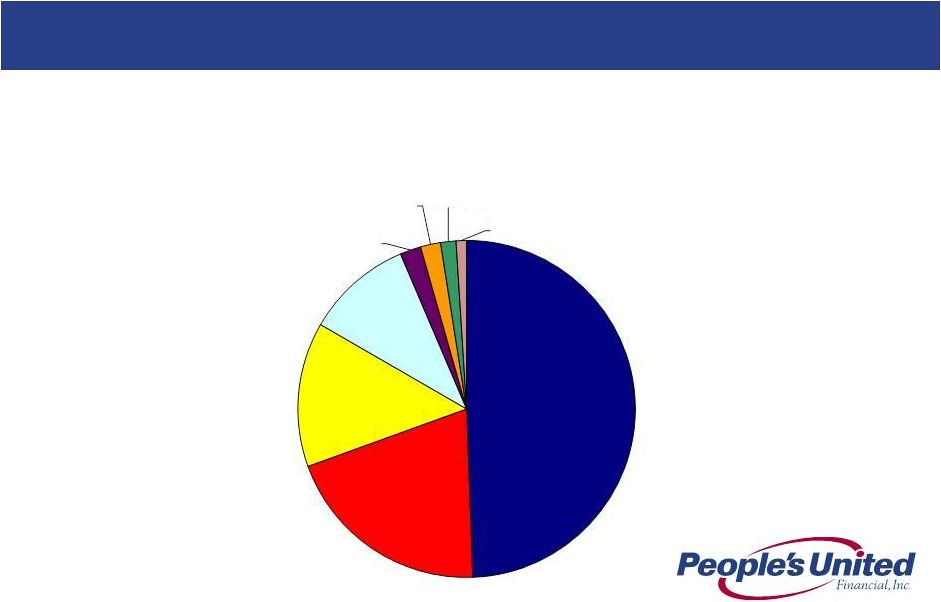 38
Balance Sheet Funding Detail
1Q14 Balance Sheet Funding
$33.1 BN
($ in billions)
85% funded by organic deposits, customer repurchase agreements and
common equity
Retail Deposits, $16.4,
49%
Commercial Deposits,
$6.6, 20%
Stockholders' Equity,
$4.6, 14%
Fed Funds & FHLB
Borrowings, $3.4, 10%
Brokered Deposits, $0.7,
2%
Subordinated
Borrowings & Sr Notes,
$0.6, 2%
Customer Repurchase
Agreements, $0.5, 2%
Other Liabilities, $0.3,
1% |
 39
Deposits
Linked Quarter Change
(in $ millions)
Total
23,666
Retail ^
Annualized Linked QTD change
19.7%
Commercial
22,557
16,195
17,029
6,362
6,637
275
834
Dec 31, 2013
Retail
Commercial
Mar 31, 2014
^ Retail includes brokered deposits of $115MM and $663MM at December
31, 2013 and March 31, 2014, respectively |
 40
Non-Interest Income
Linked Quarter Change
(in $ millions)
82.5
79.9
1.9
1.0
(2.4)
(0.9)
(0.5)
(0.2)
(1.3)
(0.2)
4Q 2013
Operating
Lease
Income
Insurance
Customer Int.
Rate Swap
Income
Bank Service
Charges
Loan
Prepayment
Fees
Brokerage
Commissions
Gain on Resi
Mtg Loan
Sales
Other
1Q 2014 |
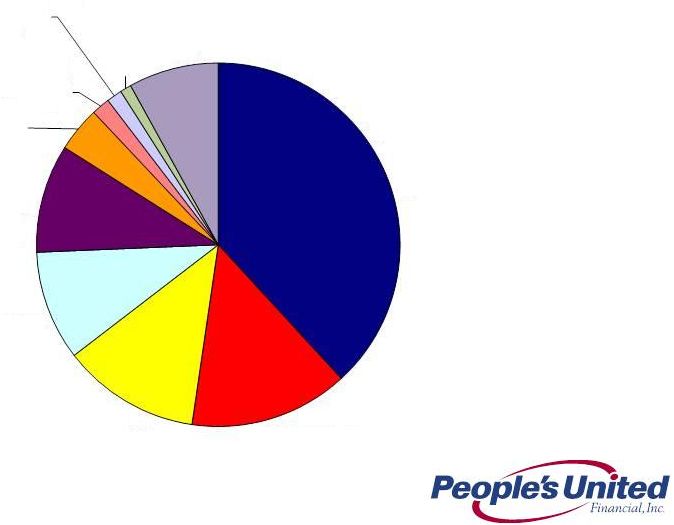 41
Non-Interest Income by Category
(in $ millions)
1Q14 Total Non-Interest Income
$79.9MM
Bank Service
Charges
$30.5
38%
Operating Lease
Income
$11.3
14%
Investment
Management Fees
$9.8
12%
Commercial
Banking Fees
$7.8
10%
Insurance
Revenue
$7.7
10%
Brokerage
Commissions
$3.2
4%
BOLI
$1.3
2%
Merchant
Services
Income, Net
$1.1
1%
Net GOS
of Loans
$0.8
1%
Other
$6.4
8% |
   42
Total
Non-Operating
Operating
Non-Interest Expense
Linked Quarter Change
(in $ millions)
208.7
216.7
207.7
4.2
(0.4)
2.7
2.3
1.5
(2.3)
211.5
1.0
5.2
4Q 2013
Non-
Operating
Prof. &
Outside
Operating
Lease
Comp. &
Benefits
Occ. &
Equip.
Other
1Q 2014 |
 43
Non-Interest Expense by Category
(in $ millions)
1Q14 Non-Interest Expense
Total: $216.7MM; Operating: $211.5MM
Comp. & Benefits
$110.4
51%
Occupancy &
Equipment
$38.0
18%
Professional &
Outside Services
$15.3
7%
Operating Lease
Expense
$11.1
5%
Regulatory
Assessments
$8.7
4%
Amort. Of Acq.-
related Intangible
Assets
$6.2
3%
Stationery,
Printing, Postage &
Telephone
$5.4
2%
Advertising and
Promotion
$2.5
1%
Other
$19.1
9% |
 44
Efficiency Ratio* (%)
Last Five Quarters
62.7%
61.4%
62.2%
62.8%
63.9%
1Q 2013
2Q 2013
3Q 2013
4Q 2013
1Q 2014
Note: * Operating lease expense excluded from non-interest expense and offset against operating
lease income within non-interest income. Amortization of investments in affordable housing
projects excluded from non-interest income and included as a component of income tax
expense |
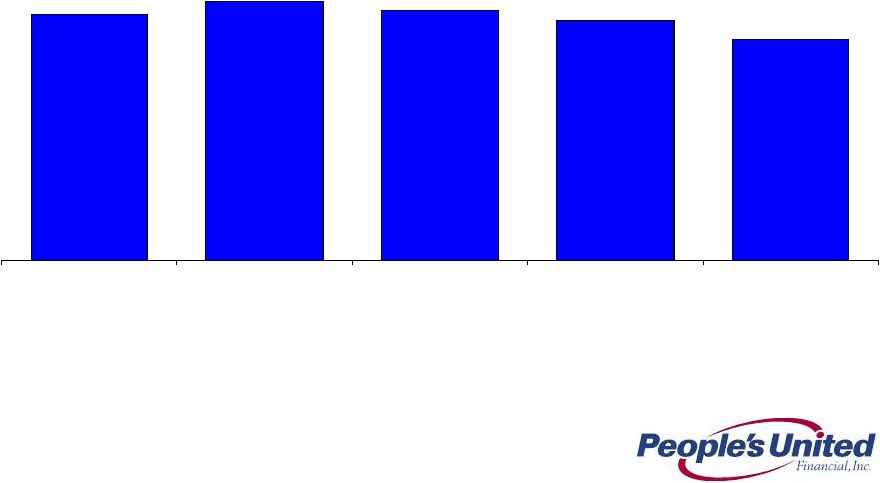 45
Operating ROAA (%)
Last Five Quarters
0.77%
0.81%
0.78%
0.75%
0.69%
1Q 2013
2Q 2013
3Q 2013
4Q 2013
1Q 2014 |
 46
Operating ROATE (%)
Last Five Quarters
8.1%
9.3%
9.8%
9.8%
9.3%
1Q 2013
2Q 2013
3Q 2013
4Q 2013
1Q 2014 |
 47
Operating Dividend Payout Ratio (%)
Last Five Quarters
91%
83%
83%
83%
86%
1Q 2013
2Q 2013
3Q 2013
4Q 2013
1Q 2014 |
 48
Substantial Progress Over the Last Five Years
Growing Loans, Deposits and Returning Capital to Shareholders
Growth has outpaced peers on the key metrics of loans per share and
deposits per share
This has occurred while we have returned $2.2BN to shareholders
during this period. Returns of capital were in the form of both
dividends ($1.1BN) and share repurchases ($1.1BN) which represents
approximately 50% of our current market capitalization
Line Item
PBCT
Peer
Median
PBCT Vs.
Peers
5-Year Loans Per Share CAGR
14.3%
-0.4%
+14.7%
5-Year Deposits Per Share CAGR
13.0%
1.0%
+12.0%
Notes:
5-Year CAGR figures based on 1Q 2009 to 1Q 2014 data
|
 49
Attractive Risk Profile
Ability to maintain strong credit quality
Conservative credit culture marked by no credit “events”
Median net charge-offs / average loans since 2007 have been 19 bps
Well-diversified commercial and retail banking portfolios
Low operating risk profile
Consistently profitable throughout the credit cycle
Straightforward
portfolio
of
products
–
no
complex
financial
exposures
Held credit ratings of A3 / BBB+ / A-
/ A throughout the credit crisis as rated by Moody’s,
S&P, Fitch and DBRS, respectively
Robust liquidity
Strong deposit market share in most core markets
Unused FHLB of Boston borrowing capacity of $4.1BN
1Q 2014 loan-to-deposit ratio of 104.1% |
 50
Commercial Credit Culture and Approval Process
Well-defined credit culture and underwriting standards
Cash flow –
deal specific and global
Collateral / limited unsecured exposure with equity investment requirements and
guarantees No speculative real estate projects
Credit
structure
includes
meaningful
covenants,
appropriate
LTVs
and
monitored
advance
rates
Industry knowledge and expertise (i.e. basic industries and property types)
Seasoned relationship managers with considerable local market knowledge
Experienced senior credit officers (SCO) average 25+ years of commercial banking
experience Approval authority
Local, regional and corporate credit committee structure
>$25MM also requires Executive Risk Oversight Committee (EROC) approval
Due
diligence
begins
prior
to
the
issuance
of
a
proposal
(market
manager
&
SCO)
and
independent credit associates in Risk Management are utilized
Credit analyst / relationship manager complete detailed loan submission
Stress test cash flow for interest rate sensitivities, vacancy and rental rates
Independent field exams and appraisal review |
 51
1.00
1.24
1.32
0.50
1.00
1.50
2.00
2.50
1Q 2013
2Q 2013
3Q 2013
4Q 2013
1Q 2014
PBCT
Peer Group Median
Top 50 Banks
Last Five Quarters
Asset Quality
NPAs / Loans & REO* (%)
*
Non-performing assets (excluding acquired non-performing loans) as a percentage of
originated loans plus all REO and repossessed assets; acquired non-performing
loans excluded as risk of loss has been considered by virtue of (i) our estimate of
acquisition-date fair value, (ii) the existence of an FDIC loss sharing agreement, and/or (iii)
allowance for loan losses established subsequent to acquisition Source: SNL Financial and
Company filings Notes: Top 50 Banks represents the largest 50 banks by total assets in each
respective quarter 18 of 20
Peers and 42 of Top 50 Banks reporting for 1Q 2014 |
 52
0.12
0.22
0.23
0.00
0.10
0.20
0.30
0.40
1Q 2013
2Q 2013
3Q 2013
4Q 2013
1Q 2014
PBCT
Peer Group Median
Top 50 Banks
Asset Quality
Net Charge-Offs / Avg. Loans* (%)
*
Excluding acquired loan charge-offs, PBCT’s charge-off ratio was
0.09%, 0.17%, 0.16%, 0.18% and 0.18% in 1Q 2014, 4Q 2013, 3Q 2013, 2Q
2013 and 1Q 2013, respectively Last Five Quarters
Source: SNL Financial and Company filings
Notes: Top 50 Banks represents the largest 50 banks by total assets in each respective
quarter
49 of Top 50 Banks reporting for 1Q 2014 |
 53
Notes:
Capital Ratios
Last Five Quarters
1Q 2013
2Q 2013
3Q 2013
4Q 2013
1Q 2014
People’s United Financial
Tang. Com. Equity/Tang. Assets
9.6%
8.7%
8.5%
7.9%
8.0%
Leverage Ratio
1, 5
10.0%
9.3%
9.2%
8.3%
8.4%
Tier 1 Common
²
12.4%
11.6%
11.4%
10.2%
10.1%
Tier 1 Risk-Based Capital
3, 5
12.5%
11.6%
11.4%
10.2%
10.1%
Total Risk-Based Capital
4, 5
13.7%
12.8%
12.6%
11.3%
11.2%
People’s United Bank
Leverage Ratio
1, 5
9.7%
9.5%
9.5%
9.1%
9.1%
Tier 1 Risk-Based Capital
3, 5
12.1%
11.9%
11.8%
11.1%
11.0%
Total Risk-Based Capital
4, 5
13.5%
13.2%
13.2%
12.4%
12.2%
1.
Leverage (core) Capital represents Tier 1 Capital (total stockholder’s equity, excluding: (i)
after-tax net unrealized gains (losses) on certain securities classified as available for
sale; (ii) goodwill and other acquisition-related intangibles; and (iii) the amount recorded in accumulated other comprehensive income (loss)
relating to pension and other postretirement benefits), divided by Adjusted Total Assets (period end
total assets less goodwill and other acquisition-related intangibles) 2.
Tier 1 Common represents Common Equity Tier 1 Capital (calculated in accordance with the Basel III
Final Rule issued in July 2013) divided by Total Risk- Weighted Assets 3.
Tier 1 Risk-Based Capital represents Tier 1 Capital divided by Total Risk-Weighted Assets 4.
Total Risk-Based Capital represents Tier 1 Capital plus subordinated notes and debentures, up to
certain limits, and the allowance for loan losses, up to 1.25% of total risk weighted assets,
divided by Total Risk-Weighted Assets
5.
Well capitalized limits under current capital rules for the Bank are: Leverage Ratio, 5%; Tier 1
Risk-Based Capital, 6%; and Total Risk-Based Capital, 10% |
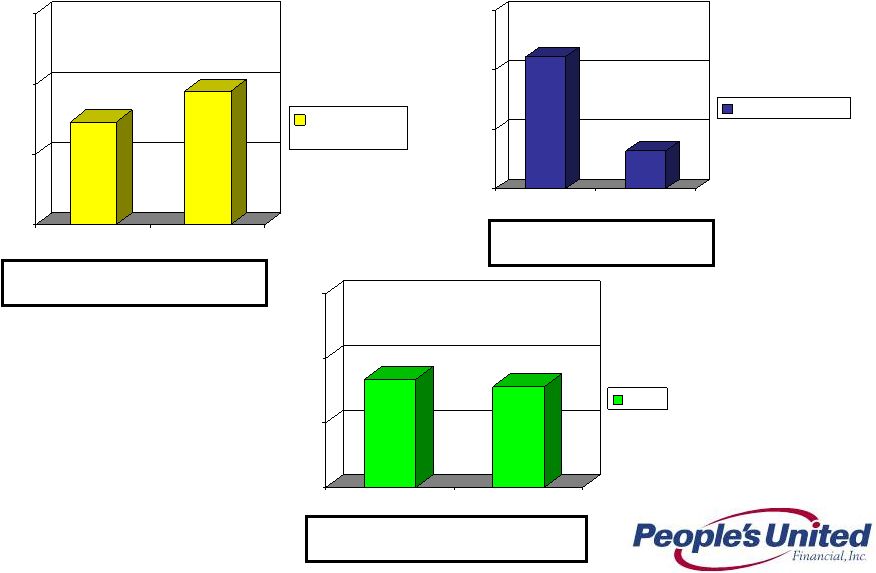 54
Allowance for Loan Losses
Originated Portfolio Coverage Detail as of March 31, 2014
(in $ millions)
0.73%
0.95%
0.00%
0.50%
1.00%
1.50%
NPLs:Loans
ALLL:Loans
Commercial
Banking
1.11%
0.32%
0.00%
0.50%
1.00%
1.50%
NPLs:Loans
ALLL:Loans
Retail Banking
Commercial ALLL -
$160.0 million
129% of Commercial NPLs
Retail ALLL -
$20.0 million
28% of Retail NPLs
Total ALLL -
$180.0 million
93% of Total NPLs
0.84%
0.78%
0.00%
0.50%
1.00%
1.50%
NPLs:Loans
ALLL:Loans
Total |
 55
Name
Position
Years in
Banking
Professional
Experience
Jack Barnes
President & CEO, Director
30+
People’s United Bank (SEVP, CAO),
Chittenden, FDIC
Kirk Walters
SEVP & CFO (People’s United
Financial, Inc.), Director
25+
People’s United Bank, Santander, Sovereign,
Chittenden, Northeast Financial
Galan Daukas
SEVP Wealth Management
25+
Washington Trust, The Managers Funds,
Harbor Capital Mgmt
Sara Longobardi
SEVP Retail & Business Banking
20+
People’s United Bank
Dave Norton
SEVP & Chief HR Officer
3+
People’s United Bank, New York Times,
Starwood, PepsiCo
Lee Powlus
SEVP & Chief Administrative Officer
25+
People’s United Bank, Chittenden, Alltel
David Rosato
SEVP & CFO (People’s United Bank)
25+
People’s United Bank, Webster, Allfirst
Chantal Simon
SEVP & Chief Risk Officer
20+
People’s United Bank, Merrill Lynch US Bank,
Lazard Freres & Co.
Jeff Tengel
SEVP Commercial Banking
30+
People’s United Bank, PNC, National City
Bob Trautmann
SEVP & General Counsel
20+
People’s United Bank, Tyler Cooper & Alcorn
Management Committee |
 56
Solid Governance Structure
Board of Directors
People’s United
Financial, Inc.
Board of Directors
People’s United Bank
The Management
Committee
Management
Committees
Enterprise
Risk
Committee
Compensation,
Nominating &
Governance Committee
Audit
Committee
Treasury &
Finance
Committee
Regulatory
Steering
Committee
Executive Risk
Oversight Committee
Asset and Liability
Committee
Capital Management
Committee
Credit Policy
Committee
Asset
Quality
Committee
Expense Management
Oversight
Committee
Model Risk
Management
Committee
Disclosure
Committee
New Product
Approval
Committee
Senior Trust
Management
Committee
Transactions with
Affiliates Committee
HR
Administrative
Committee
CRA and Community
Development
Committee
Executive Technology
Committee
Real Estate
Committee
Marketing
Committee
Loan Review
Committee
Trust
Committee
Fraud Risk
Management
Committee |
 57
Peer Group
Firm
Ticker
City
State
1
Associated
ASBC
Green Bay
WI
2
BancorpSouth
BXS
Tupelo
MS
3
City National
CYN
Los Angeles
CA
4
Comerica
CMA
Dallas
TX
5
Commerce
CBSH
Kansas City
MO
6
Cullen/Frost
CFR
San Antonio
TX
7
East West
EWBC
Pasadena
CA
8
First Niagara
FNFG
Buffalo
NY
9
FirstMerit
FMER
Akron
OH
10
Fulton
FULT
Lancaster
PA
11
Huntington
HBAN
Columbus
OH
12
M&T
MTB
Buffalo
NY
13
New York Community
NYCB
Westbury
NY
14
Signature
SBNY
New York
NY
15
Susquehanna
SUSQ
Lititz
PA
16
Synovus
SNV
Columbus
GA
17
Valley National
VLY
Wayne
NJ
18
Webster
WBS
Waterbury
CT
19
Wintrust
WTFC
Lake Forest
IL
20
Zions
ZION
Salt Lake City
UT |
 58
Non-GAAP Financial Measures and Reconciliation to GAAP
In addition to evaluating People’s United Financial’s results
of operations in accordance with U.S. generally accepted
accounting principles (“GAAP”), management routinely supplements this evaluation with an analysis of
certain non-GAAP financial measures, such as the efficiency and
tangible equity ratios, tangible book value per share and
operating earnings metrics. Management believes these non-GAAP financial measures provide
information useful to investors in understanding People’s United
Financial’s underlying operating performance and trends,
and facilitates comparisons with the performance of other banks and thrifts. Further, the efficiency ratio and
operating earnings metrics are used by management in its assessment of
financial performance, including non- interest expense
control, while the tangible equity ratio and tangible book value per share are used to analyze the
relative strength of People’s United Financial’s capital
position. The efficiency ratio, which represents an approximate measure of the
cost required by People’s United Financial to generate a
dollar of revenue, is the ratio of (i) total non-interest expense (excluding goodwill impairment charges,
amortization of other acquisition-related intangible assets, losses
on real estate assets and non-recurring expenses) (the
numerator) to (ii) net interest income on a fully taxable equivalent ("FTE") basis plus total non-interest income
(including the FTE adjustment on bank-owned life insurance
("BOLI") income, and excluding gains and losses on sales
of assets other than residential mortgage loans and acquired loans, and non-recurring income) (the
denominator). In addition, operating lease expense is excluded from
total non-interest expense and netted against operating
lease income within non-interest income to conform with the reporting approach applied to our other fee-
based businesses that are already presented on a net basis.
People’s United Financial generally considers an item of
income or expense to be non-recurring if it is not similar to an
item of income or expense of a type incurred within the last two
years and is not similar to an item of income or expense of a type reasonably expected to be incurred
within the following two years. |
 59
Non-GAAP Financial Measures and Reconciliation to GAAP
Operating earnings exclude from net income those items that management
considers to be of such a non-recurring or infrequent nature
that, by excluding such items (net of income taxes), People’s United Financial’s results can
be measured and assessed on a more consistent basis from period to
period. Items excluded from operating earnings, which include,
but are not limited to, merger-related expenses (including acquisition integration and
other costs), charges related to executive-level management
separation costs, severance-related costs and writedowns of
banking house assets, are generally also excluded when calculating the efficiency ratio. Operating
earnings per share is derived by determining the per share impact of
the respective adjustments to arrive at operating earnings and
adding (subtracting) such amounts to (from) GAAP earnings per share. Operating return
on average assets is calculated by dividing operating earnings
(annualized) by average assets. Operating return on average
tangible stockholders' equity is calculated by dividing operating earnings (annualized) by average
tangible stockholders' equity. The operating dividend payout ratio is
calculated by dividing dividends paid by operating earnings for
the respective period. The tangible equity ratio is the ratio of (i) tangible
stockholders’ equity (total stockholders’ equity less goodwill
and other acquisition-related intangible assets) (the numerator) to
(ii) tangible assets (total assets less goodwill and other
acquisition-related intangible assets) (the denominator). Tangible book value per share is calculated by
dividing tangible stockholders’ equity by common shares (total
common shares issued, less common shares classified as treasury
shares and unallocated Employee Stock Ownership Plan ("ESOP") common shares).
In light of diversity in presentation among financial institutions, the
methodologies used by People’s United Financial for
determining the non-GAAP financial measures discussed above may differ from those used by other
financial institutions. Please refer to People’s United
Financial’s latest Form 10-Q regulatory filing for detailed
reconciliations to GAAP figures. |
 For
more information, investors may contact: Peter Goulding, CFA
203-338-6799
peter.goulding@peoples.com |
